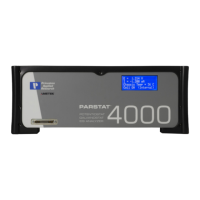PARSTAT 4000 Hardware Manual
PARSTAT 4000 Hardware Manual 16
3.2.1.3. SYNC ADC INPUT
This BNC allows you to monitor an auxiliary signal in the + 10 V range
with 16-bit resolution. This signal is monitored synchronously with
the E and I channels.
3.2.1.4. DAC OUTPUT
Rear-panel BNC delivers a precise DC voltage in the + 10 V range.
This output can be used to control the rotation speed of rotating disk
electrodes (RDEs). CAUTION: The voltage at this connection will
be uncontrolled at power-on until the system fully boots (~ 1 min after
power-on). As a result, no connection should be made until system
has completely booted, or in the case of an RDE (i.e., the 616/636
systems), leave the power off on the RDE until the system is
completely booted.
3.2.1.5. AUXILIARY INTERFACE
This DB9 female connector provides several functions including the
signals required to drive a Model 303A Static Mercury Drop
Electrode. If using a Model 303A, you must connect the electrode to
the AUXILIARY INTERFACE connector via the Model 507 Interface.
AUXILIARY INTERFACE can also turn the Model 616 Rotating Disk
Electrode on and off with the STIR signal issued with the VersaStudio
software. See Section 4.4. for the pin assignments. PMC AUX01
cable is now available to convert these pins to convenient BNCs.
3.2.1.6. E MON
This rear panel BNC connector outputs the analog of the reference
voltage (±10V range, 50Ω output impedance), however, the polarity
at E MON is opposite that at the cell.
3.2.1.7. I MON
This rear panel BNC connector outputs the analog of the current with
±2V corresponding to +/- full scale current range, 50Ω output
impedance.
NOTE: If the PARSTAT 4000 is operating in “float” mode, then all connections
to the rear panel must be floating (isolated from ground) as well. If a
grounded connection is made to any rear panel connectors (any non-
isolated connection), then the PARSTAT 4000 system will no longer
be isolated itself, and ground loops will result in excessively noisy
data.

